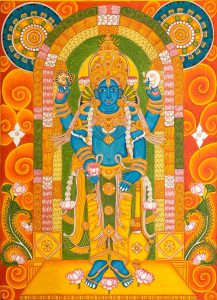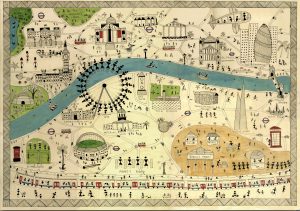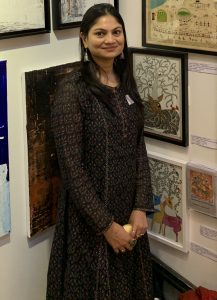Shobana Nair
In our performing arts section, Arts Editor of Jaggery lit Srividya Ramamurthy had a virtual sit-down session with Shobana Nair. Shobana Nair currently resides in United Kingdom. While Shobana also creates artwork with Madhubani, Warli, Gond; She specializes in an art form so unique to Kerala, India. The art form captures vivid expressions and is known for its vibrancy through colors.
This conversation brings to life in knowing about Shobana and also the “Kerala Murals”. Without any further ado let’s begin this conversation with the artist Shobana Nair.
It is so lovely to meet and chat with you virtually Shobana. Can you tell us your background? How did you get interested and learn to do murals?
I was born and raised in New Delhi. I worked in financial services for a long time. However since my father was in the travel industry and mother is a fine art and porcelain artist. This meant that growing up, we got the chance to travel to many unique places around India and explore the varied art forms in India Every state in India is like a country with its unique language, culture, cuisine and of course its art. Since my father’s roots are from Kerala, many of our summer holidays were spent there, so I got the chance to discover many of the temple murals. In one of my recent visits to Kerala, I had an opportunity to learn this art from an artist who has dedicated his life to this art form – Mr Surendran K U.
That’s interesting to know. Father’s home state and mother’s talent in fine arts. Seems like a perfect jugalbandi here.
Smiles……
Is this art form called Kerala Murals or does it have any other name? What is it locally called perhaps in the native language?
Kerala Mural is a form of wall fresco and was a form of expression from the 9th to the 19th century. These paintings are idealistic reproduction of humans, deities, animals and trees with vibrant colors and rich /delicate strokes. The themes usually revolve around epic scenes from Hindu mythology. Traditionally the murals used Panchavarna (five colors), namely red, yellow, green, black and white. These colors were made from natural elements such as cinnabar for red, manayola for yellow etc. These were then mixed with locally available resources like coconut oil and gum from the mango tree. Kerala is the only place that has retained relics which represent the classical traditions of wall mural paintings in India: aside from perhaps the Ajanta/ Ellora in Western Maharashtra.

Any painting art form requires a lot of perseverance, in your mind what is the hardest part of this art??
Kerala mural painting has a meditative quality. It is a slow art that encourages you to look within. The hardest part of the art is the detailing and the intricacy. For example, In Kerala Art, I apply a method calling ‘Stippling’ technique or simply put dot painting. In this process, the paint is applied on the canvas using dots. There are at least 2 or 3 such levels of coating applied to give depth to the painting. These are done using really thin brushes. Although it requires a lot of time and patience, it is also the part that I enjoy the most.
How different is this compared to painting the murals on a wall?
While I haven’t done a Kerala Mural painting on a wall, asking the same question to my teacher, I have heard that there are no major differences in painting the mural on the wall to a canvas. In my own personal take as an artist, painting on a wall requires you to ensure you have the right perspectives. This definitely requires some practice and well thought through process. While that is a relatively easier when working on canvas.
So, tell us more about how you went about from a Financial Services background to creating these beautiful murals?
Although I used to paint before, I really got the idea when we bought our home in London in 2017. I painted wall murals on the staircase and bedroom walls, using Madhubani (Artform from Bihar), Gond (technique from Madhya Pradesh) and Warli (tribal art from Maharashtra) Folk art techniques. This added a great of splash color to our home and was very well received by visitors. This motivated me to start painting professionally. You can see a picture of what I did.

If you lived close by, I would have asked you to commission an artwork on the walls of my home as well. (Both have a great smile)
Well, I can definitely work on commissioning on your walls with my paintings on canvas.
That’s brilliant! We should talk more about that in a minute but interesting to know is that, you are not just into Kerala Murals but also into a host of other art forms.
Yes, A lot of them have been self-learning. I visit a lot of artists and their art form. I have been fascinated to arts in general especially from these little villages. I also like to have them on the clothes like Sari’s etc. I just like the whole vibrancy and simplicity of these arts.
Tell us more about your art shows and exhibits.
I had my first exhibition in Feb 2019 at the Parallax Art Fair in Central London. It was a great experience and my paintings were very well received. I have had participated in several art exhibitions in London and online as well.
But my turning point came when one of my paintings – Map of London in Warli Tribal Art was selected for London’s prestigious Royal Academy of Arts Summer Exhibition in 2019. With a selection ratio of 10%, given the large number of applicants, this was a great motivation for me. Aside from this, I also display my work on online sites like Etsy, Instagram and Facebook.

That is an interesting way to show the Map of London indeed. What a great idea!
Warli art form is local to a place called Thane in Maharashtra India. In this art form the locals depicts their day to day life in imagery using geometric forms and patterns. Also visiting and going around London with my family and by myself, I saw these in my own artist’s lens, and this art form is what came to my mind. Thus, the seeding idea to represent Map of London in Warli art form.
Wow! I can relate to imagery that stays with you as you see a visual. What are your plans or aspirations for the future??
I aspire to make ‘relatable folk art’ which people around the world can understand and appreciate. My experience with the Map of London in Warli, where I painted a Western city map in a Indian tribal art form, really brought home the possibility that the arts of our cultures can be depicted in far more ways than just the traditional; while at the same time staying true to the techniques passed down to us through the generation. An inveritable East meets West.
In this small way, I hope to preserve and promote the Indian folk and tribal art forms. I keep my eyes and mind open for traditional art forms around the world, but the amazing variety in India are enough for one lifetime 🙂
So, do you commission paintings for individuals that might not be as talented as you are but have an eye for art form and what they would like to see in their homes or other settings?
Definitely! For an artist bringing something to life that a client can relate to forever is the most satisfying experience. Commissioning is a collaborative effort between the client and the artist, a process that I enjoy the most!
Anyone who is keen on commissioning any form of folk/tribal art can reach me on my Etsy, facebook, Instagram or my web page.
Indeed! What advice would you give to others who might be interested in learning Indian folk arts??
Indian folk art is very diverse and vibrant. If you ever get the opportunity to learn any of them, I would highly encourage you to. The Kerala Mural Art form does require tremendous time and patience. It requires hours of study, understanding the use of colors and techniques.
My parents have now retired to Kochi. When I visit them on my holidays, I am continuously fortunate to be able to learn this art form from artists in Kerala who have done this their whole life. The amount of dedication is just mind boggling to me. If you are able to find a teacher like that, you are indeed fortunate, so make the most of that. The vibrancy, the colors and the unique techniques will make it a very satisfying and rewarding experience. This is my very personal take; traditionally these paintings were limited to temples, churches and palaces. However slowly they are making their way into urban homes and offices. There is still lot of scope to develop and promote this art form. More research and reimagination is needed to contemporize and revive this art form. I aspire to contribute to this revival in my own way. It is a whole ocean of possibilities; all it takes is an earnest approach to learning and mastering any art form.
Excellent! It was such a lively conversation with you. Thank you so much for spending your time and talking with us. On behalf of Jaggery, we wish you all the very best.
![]()

Shobana Nair is an artist based out of United Kingdom. Her parents would travel to different parts of India and one of the favorite things to do was to visit different artists, tribal artists. She became deeply interested in these art forms so local to each specific region in their travels. Growing up in New Delhi also meant a place of melting pot of different artists showcasing their art forms, having live demonstrations of their artwork. All of these piqued her curiosity and her interests. Shobana was pursuing a career in Financial services, while she thought of painting a wall leading up to the staircase in her new home. This drew so much of appreciation and encouragement from her family and friends. Later a big turning point came when she submitted to the London’s prestigious Royal Academy of Arts Summer Exhibition in 2019. Her art using a Warli painting depicting the map of London. Her art work was chosen at this prestigious academy. This came as a huge motivation and pat on the artist back. While she paints in Madhubani, Warli, Gondh techniques, Kerala murals is a form that she is now focusing more now.
Contact Shobana and see some of her artwork on the following pages:



